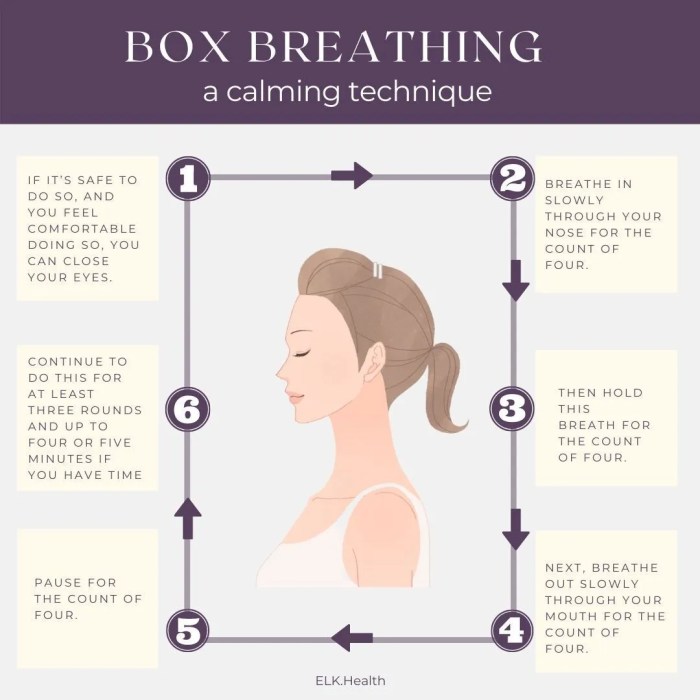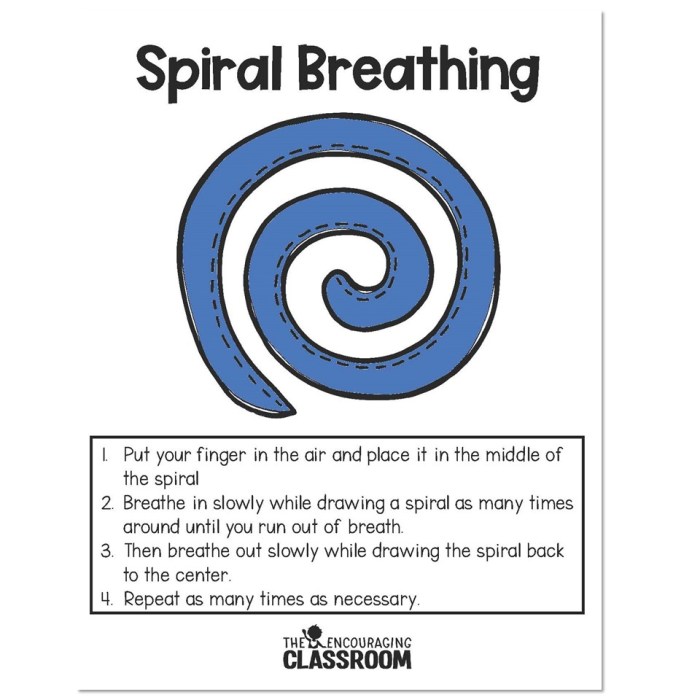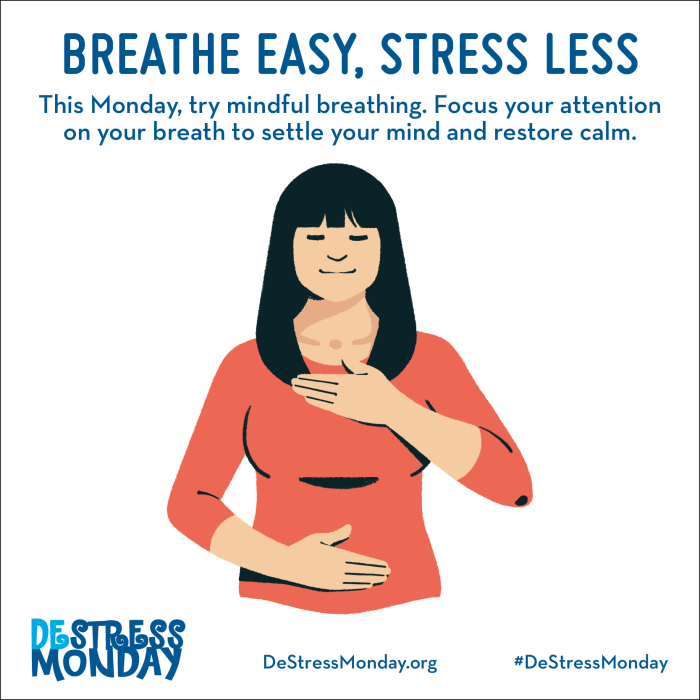Kicking off with 5 Simple Breathing Exercises to Calm Your Mind, this article delves into the significance of incorporating breathing techniques for mental tranquility and overall well-being. From diaphragmatic breathing to mindful breathing meditation, these exercises offer a pathway to inner peace and relaxation.
Introduction to Breathing Exercises

Breathing exercises are a powerful tool to calm the mind and reduce stress in our daily lives. The way we breathe directly affects our nervous system, and by practicing specific techniques, we can effectively manage anxiety and promote relaxation.
Importance of Breathing Exercises
Breathing exercises play a crucial role in regulating our body’s stress response. When we are stressed or anxious, our breathing tends to become shallow and rapid, signaling to the brain that we are in a state of distress. By practicing deep breathing techniques, we can activate the relaxation response, slowing down our heart rate and calming our mind.
- Deep breathing exercises help to increase oxygen flow to the brain, promoting clarity of thought and focus.
- By focusing on our breath, we can redirect our attention away from racing thoughts and worries, bringing a sense of calmness and presence.
- Regular practice of breathing exercises can improve our overall mental well-being, reducing the impact of chronic stress on our bodies.
Diaphragmatic Breathing Technique

Diaphragmatic breathing, also known as deep breathing or abdominal breathing, is a breathing technique that involves fully engaging the diaphragm muscle to promote efficient oxygen exchange in the body. This technique differs from shallow breathing, which involves taking quick, shallow breaths that do not fully engage the diaphragm.
How to Practice Diaphragmatic Breathing, 5 Simple Breathing Exercises to Calm Your Mind
To practice diaphragmatic breathing, follow these simple steps:
- Find a comfortable and quiet place to sit or lie down.
- Place one hand on your chest and the other on your abdomen.
- Inhale deeply through your nose, allowing your abdomen to expand as you fill your lungs with air.
- Exhale slowly through your mouth, feeling your abdomen contract as you release the air.
- Repeat this process for several minutes, focusing on the rise and fall of your abdomen with each breath.
Physiological Effects of Diaphragmatic Breathing
Diaphragmatic breathing helps to activate the body’s relaxation response, reducing stress and anxiety levels.
Diaphragmatic breathing also improves oxygen flow to the brain, promoting clearer thinking and enhanced concentration. Additionally, this technique can help lower blood pressure, improve digestion, and boost overall respiratory function. By incorporating diaphragmatic breathing into your daily routine, you can experience a greater sense of calm and well-being in both body and mind.
Box Breathing Exercise

Box breathing, also known as square breathing, is a technique used to calm the mind and body by regulating the breath. This practice originates from ancient yogic traditions and has been adopted by modern mindfulness and relaxation techniques.
How to Perform Box Breathing
- In a comfortable seated position, take a deep breath in through your nose for a count of four.
- Hold your breath for a count of four.
- Exhale slowly through your mouth for a count of four.
- Hold your breath again for a count of four.
- Repeat this cycle for several minutes, focusing on the rhythm and consistency of your breath.
Effectiveness of Box Breathing
Box breathing has been shown to be effective in reducing stress, anxiety, and promoting a sense of calmness. Many individuals who practice box breathing regularly report feeling more centered, focused, and relaxed after each session. By incorporating this simple breathing exercise into your daily routine, you can experience a greater sense of mental clarity and emotional balance.
Nadi Shodhana (Alternate Nostril Breathing)

Nadi Shodhana, also known as Alternate Nostril Breathing, is a powerful breathing technique that is commonly used in yoga and meditation practices. This technique involves breathing through alternate nostrils to balance the flow of energy in the body and calm the mind.
Steps for Performing Nadi Shodhana
- Sit comfortably in a cross-legged position with your spine straight and shoulders relaxed.
- Place your left hand on your left knee with the palm open to the sky.
- Bring your right hand to your face and use your thumb to close your right nostril.
- Inhale deeply through your left nostril, then use your ring finger to close your left nostril while releasing your right nostril.
- Exhale through your right nostril, then inhale through the right nostril.
- Close the right nostril again with your thumb, release the left nostril, and exhale through the left nostril.
- This completes one round of Nadi Shodhana. Repeat for several rounds, focusing on the breath and maintaining a steady rhythm.
Mental Benefits of Nadi Shodhana
Nadi Shodhana is believed to have various mental benefits when incorporated into a daily routine. Some of the potential benefits include:
- Calming the mind and reducing stress and anxiety levels.
- Improving focus, concentration, and mental clarity.
- Balancing the left and right hemispheres of the brain for enhanced cognitive function.
- Promoting a sense of inner peace and harmony within oneself.
Mindful Breathing Meditation: 5 Simple Breathing Exercises To Calm Your Mind
Mindful breathing is a form of meditation that involves focusing your attention on your breath. It is closely connected to mindfulness practices as it encourages you to be present in the moment, fully aware of your breath and the sensations it brings. This practice helps cultivate a sense of calm and centeredness, allowing you to let go of distractions and worries.
Tips for Starting a Mindful Breathing Meditation Session
- Find a quiet and comfortable place to sit or lie down.
- Close your eyes and take a few deep breaths to relax your body.
- Focus on the sensation of your breath as it enters and leaves your nostrils.
- Notice the rise and fall of your chest or abdomen with each breath.
- If your mind wanders, gently bring your focus back to your breath without judgment.
Benefits of Mindful Breathing for Focus and Mental Clarity
Mindful breathing can greatly enhance your focus and mental clarity by training your mind to stay present and attentive. By practicing mindful breathing regularly, you can experience:
- Improved concentration and attention span.
- Reduced stress and anxiety levels.
- Enhanced emotional regulation and self-awareness.
- Increased ability to make clear and thoughtful decisions.
Concluding Remarks

In conclusion, the practice of these breathing exercises can serve as a powerful tool in managing stress, anxiety, and promoting mental clarity. By integrating these techniques into your daily routine, you can embark on a journey towards a calmer and more balanced mind.